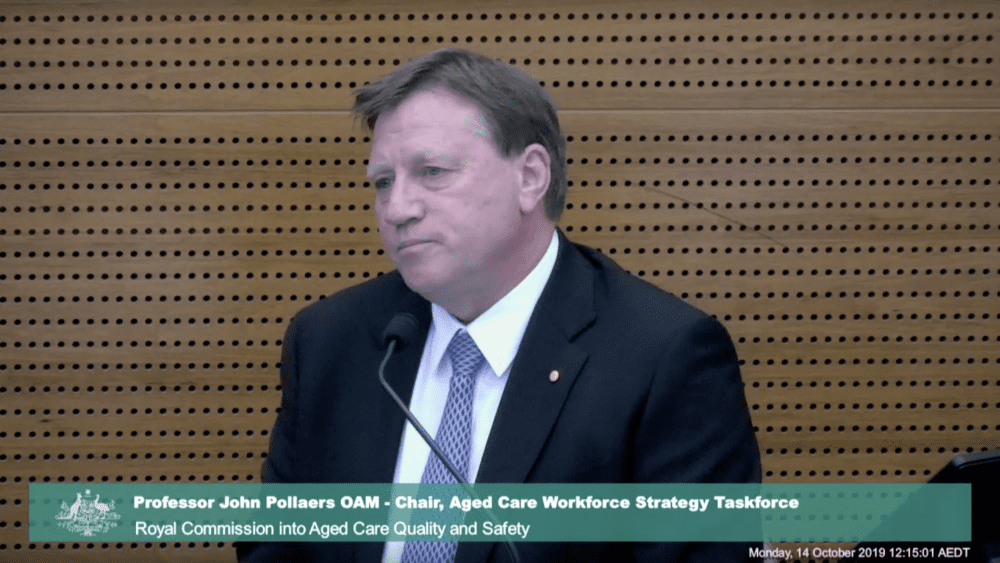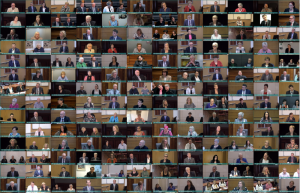
This week the royal commission is focussing on staffing in aged care, a topic that has emerged as the sector’s largest and most insidious problem.
Monday’s sombre opening marked the passing of the chair of the commission, Richard Tracey. Commissioner Lynelle Briggs said Commissioner Tracey used the words “cruel” and “unkind” to describe aspects of Australia’s aged care system and he encouraged the royal commission to make “transformative” changes, rather than “change at the margin”, given the degree of “substandard care”.
Senior counsel assisting the royal commission, Peter Rozen QC, said Mr Tracey’s passing was “keenly felt” by all of the royal commission team.
Many friends, family and colleagues attended the royal commission on Monday morning to hear the commission’s remarks, and a minute of silence was held to mark his passing.
The commission then resumed, laying bare the extent of the workplace issues facing the sector.

Mr Rozen pointed out that, to date, the royal commission had received 6,631 submissions. More than half of these raised concerns about workforce related issues, he said. He said 85 per cent of the 296 witnesses that have given evidence so far have comments on the workforce.
“The older Australians and their family members who have given evidence to this royal commission have told you about their lack of confidence in the aged care workforce to deliver the safe and high-quality care that older people need and deserve,” Mr Rozen said.
Problems identified include inadequate numbers, continuity of staff, the adequacy of training, low pay, and limited career paths.
“You have also heard evidence about difficulties attracting and retaining high quality people to work in aged care and the importance of selecting the right people to work in aged care,” Mr Rozen said.
Mr Rozen said aged care staff deserve greater appreciation for their work they do.
“We have heard this year is that there are thousands of people working in aged care who display selfless devotion to those for whom they care every day,” he said.
“They are looking after the most intimate needs of some of our most vulnerable citizens. They do it for little money. They’re often inadequately supported. At times they risk their own health and safety. They do all of this with love and dedication. We are all in their debt. They deserve appropriate remuneration, appropriate training and support and safe workplaces.”
The commission heard from Professor Kathy Eagar, director of the Australian Health Services Research Institute at the University of Wollongong who co-wrote the commission’s report on aged care staffing in Australia.
The report looks at how staff levels in Australia compare with other countries, in particular the US, which employs a star rating system called USA Centers for Medicare and Medicaid Services (CMS).
The report says when the US system is adjusted for Australia, more than half of all Australian aged care residents (57.6 per cent) live in homes that would have 1 or 2 star staffing levels. One of 2 stars represent “unacceptable levels of staffing”.
Of the remaining 42.4 percent of residents, 27.0 per cent are in homes that have 3 stars (acceptable staffing levels), 14.1 per cent receive 4 stars (good), and a mere 1.3 per cent are in homes with 5 stars – best practice.
“To raise the standard such that all residents receive at least a 3 star level of staffing will result in an overall increase of 20 per cent in total care staffing across Australia.,” the report states.
Across the industry, the number of registered nurses has decreased from 25 per cent to 19 per cent of the workforce over the past 12 years, while the percentage of personal care workers in the sector has risen from 50 per cent of staff to 70 per cent.
Professor Eagar said aged nurses are overburdened with paperwork. “Homes would need to spend more time on paperwork to be paid for a resident than a hospital needs to complete to be paid for a heart-lung transplant,” she said.
Ms Eager told the commission, “There are now less allied health professionals, there are less nurses, both nurse practitioners, registered nurses and enrolled nurses, all qualified nurses, and more staff with minimal training.”
Professor Eagar said the industry has moved to a model of more “homely” care which has contributed to a deskilling of the workforce, despite the fact that the aged care population is more frail than ever before, and requires more clinical care.
Professor John Pollaers, who was chair of the Aged Care Workforce Taskforce and is now a member of the Aged Care SEctor Committee – Workforce, said the government has not responded adequately to calls for change.
When he asked the government for its response to the Taskforce report he said, “I got an email response that was all of the past programs of government and I went back and said ‘look, that isn’t sufficient, I’m asking for a step-by-step response.’ I didn’t get a response to that email.”
Professor Pollaers said the fragmented nature of the industry hindered change, and the industry was “adolescent” in the way it could not organise itself.
Professor Pollaers said he believed the industry was being “oppressed” by a Department of Health that is no resourced well enough or have enough experience or weight in the current government.
“I was very surprised through the course of the work, the extent to which the Prime Minister and Cabinet were sitting on top of the minister with respect to these issues,” he said.
Professor Pollaers suggested the fraction between the government, industry and unions prevented them from tackling staffing issues.
“The way that government has positioned itself over the last few years is that, to the extent that this can be an industry issue and they can leave industry to deal with union, and then use the fragmentation as a reason to say, ‘Well, without one voice we don’t know what you’re asking’, has been… a reasonably successful approach, and, if not a strategic approach then a real shame because the answers to many of these questions have been on the table for quite some time.”
On Tuesday, the commission looked at the case of Melbourne’s Greenway Gardens nursing home, where concerned daughter Sandra Nisi installed a camera in her father’s room after he told her staff were abusing him.
The camera identified UG, as he has been called, was 85 years old and suffering from Parkinson’s disease and dementia.
Ms Nisi said the footage, which was not played to the royal commission, showed staff grabbing her father’s legs and throwing them up onto the bed, saying, “Stop shaking. You’re setting off the night alarm.”
Ms Nisi’s father had Parkinson’s disease and was living with dementia.
Other footage showed the elederly man collapsing and unresponsive as staff tried to get him out of bed with a lifting machine. At 7.30a, “the staff member lifted him up by the shirt to the bed, tapped his face, called his name, asked if he was all right. Commented that he was not right when he was unresponsive. Put him back to bed, changed his continence aid and turned him,” Staff did not attend to him then until after 9pm that night.
Another daughter, Christin Lynch, reported the findings from the footage to group operations manager, Brendan Coulton.
Mr Coulton said, “‘You know you’re breaking the law by using that camera?’… He was more interested in our usage of the camera than what happened. And then he said, ‘It’s 14 December. You’ve got to understand that we need a break for Christmas, and that on 15 January we’re going to come back and then we will look into this.”
The hearings continue.